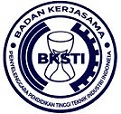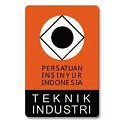Perancangan Model Klaster Industri Hilir Kelapa di Kabupaten Padang Pariaman
Abstract
ABSTRAK
Penelitian ini bertujuan untuk merancang model pada klaster industri hilir kelapa di Kabupaten Padang Pariaman dengan pendekatan sistem sehingga terbentuknya strukturisasi elemen sistem pengembangan klaster industri. Penelitian dilakukan dengan beberapa tahap. Tahap kesatu melakukan analisis potensi komoditas kelapa di Kabupaten Padang Pariaman dengan metode location quotient (LQ), Tahap kedua melakukan identifikasi melalui studi literatur dan wawancara dengan pakar berdasarkan indikator pada model diamond porter untuk mengetahui apakah komoditi kelapa punya potensi untuk dikembangkan menjadi sebuah klaster industri. Tahap ketiga menentukan jenis industri yang dapat dikembangkan dalam klaster industri hilir kelapa dengan menggunakan metode perbandingan eksponensial (MPE). Tahap keempat mengidentifikasi stakeholder yang terlibat dan bagaimana perannya di dalam klaster industri hilir kelapa dengan metoda deskriptif kualitatif. Tahap kelima mendesain peta kluster industri hilir kelapa berdasarkan model diamond porter dengan menggunakan setiap elemen yang telah didefinisikan sebelumnya. hasil penelitian didapat nilai LQ sebesar 12,5 yang menyatakan bahwa klaster industri hilir kelapa berpotensi dikembangkan di Kabupaten Padang Pariaman. Berdasarkan perhitungan MPE terdapat 8 produk prioritas yaitu: virgin coconut oil, coco fiber, arang briket, coco peat, coco vinegar, desiccated coconut, kerajinan lidi dan daun kelapa, sari kelapa nata de coco.
Kata Kunci: Kelapa, Klaster Industri, Location Quotient, Diamond Porter, MPE
ABSTRACT
This study aims to design a model for the downstream coconut industry cluster in Padang Pariaman Regency with a systems approach so that the structural elements of the industrial cluster development system are formed. The research was conducted in several stages. The first stage is to analyze the potential of coconut commodities in Padang Pariaman Regency using the location quotient (LQ) method. The second stage is to identify through literature studies and interviews with experts based on indicators on the diamond porter model to determine whether coconut commodities have the potential to be developed into an industrial cluster. The third stage is to determine the type of industry that can be developed in the downstream coconut industry cluster using the exponential comparison method (MPE). The fourth stage identifies the stakeholders involved and their roles in the downstream coconut industry cluster using a qualitative descriptive method. The fifth stage is to design a coconut downstream industry cluster map based on the diamond porter model using each of the previously defined elements. The results of the study obtained an LQ value of 12.5 which states that the downstream coconut industry cluster has the potential to be developed in Padang Pariaman Regency. Based on the MPE calculation, there are 8 priority products, namely: virgin coconut oil, coco fiber, charcoal briquettes, coco peat, coco vinegar, desiccated coconut, craft sticks and coconut leaves, coconut juice nata de coco.
Keywords: Coconut, Industrial Cluster, Location Quotient, Diamond Porter, MPE
Full Text:
PDFDOI: http://dx.doi.org/10.24014/jti.v7i2.14484
Refbacks
- There are currently no refbacks.
Copyright (c) 2021 Meilizar - Meilizar

This work is licensed under a Creative Commons Attribution-NonCommercial-ShareAlike 4.0 International License.
Jurnal Teknik Industri
P-ISSN 2460-898X | E-ISSN 2714-6235
Published by:
Industrial Engineering Department
Universitas Islam Negeri Sultan Syarif Kasim Riau, Indonesia
Office Address:
H.R. Soebrantas KM 15.5, Tampan, Pekanbaru, Riau, Indonesia 28293
email: jti.fst@uin-suska.ac.id
Indexed by:
JTI : Jurnal Teknik Industri under a Creative Commons Attribution-NonCommercial-ShareAlike 4.0 International License.















